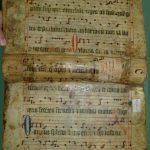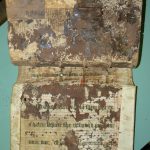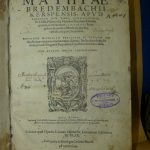A complete leaf of a choir book-sized parchment antiphonal was put onto the 16th-century host volume’s wooden boards as a protective cover. The visible side of the fragment gives the so-called O-antiphons, the characteristic Magnificat-antiphons of the last week before Christmas (from the 17th to the 23th of December). It is currently possible to lift the fragment from the front board, so it can be seen that the O-antiphons proceed on the glued side; consequently, the outer side is the recto.
The system of the O-antiphons may be slightly different in certain mediaeval traditions. When a written source listed more than seven antiphons, it means that the choir had to chant the first one before the 17th of December. Besides the O-antiphons of the canonical Office, some sources included commemorative pieces, as well, following the characteristic textual and musical form; these antiphons also needed further explanation. (The singers had to consider the date of Advent’s fourth Sunday in the given year, and had to take into account if the feast of Saint Thomas the Apostle on the 21st of December was Sunday.)
The musical notation makes it very likely that the fragment has Pauline origin. Namely, a type of the Esztergom notation specific to late Pauline scriptoria can be identified on it, in which the climacus starts with doubled puncta both in individual neumes and in compound ones without exception. On the other hand, the notator used two pens, which is also noticeable in numerous Pauline manuscripts: puncta were written with a thicker nib than other neumes to achieve an appropriate visual emphasis. If they had written other neumes and compound neumes with the same thick nib, some details would have merged into each other. In these Pauline manuscripts, the colour intensity of the puncta and the compound neumes are often different, as the ink running steadily from the pen left gradually fading signs on the parchment, and the notes beside each other in the staff system were made at different points of the writing process. (See also the description of fragment F 796, which illustrates the discussed ‘two-pen principle’.)
The Pauline origin of the fragment is affirmed by the possessor’s notes of the host volume. The probably earliest one from 1621 refers to the cloister of Remete (“under the Medvednica mountain”, near Zagreb) used by the Pauline Order at that time. The leaf of an obsolete antiphonal could easily become a book cover there.
In the light of the abovementioned considerations, it is worthy to compare the music of the fragment with the 15th—16th-century Pauline antiphonal from Remete, now kept under the shelfmark MR 8 in the Metropolitanska knjižnica Zagrebačke nadbiskupije. The antiphonal MR 8 gives the O-antiphons in the exact order of the fragment, and their melodies are almost the same, note by note. Thus the Pauline origin of the fragment is beyond any doubt.
Gábriel Szoliva OFM




